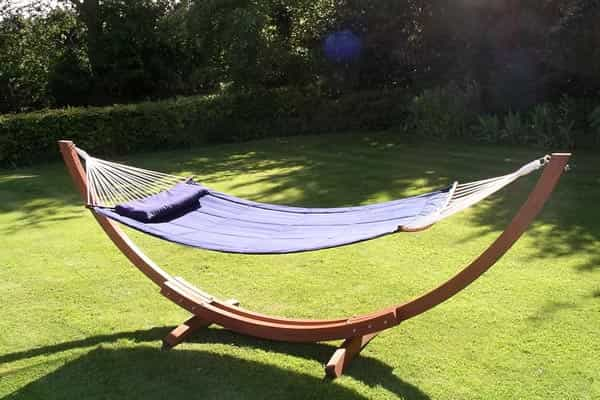Characteristics
The hammock is made up of a set of ropes, fabric or net which is suspended from the ground by hooking it to the two opposite ends. Generally, the hammock is fixed by tying the ropes around the trunks of two trees, or by passing the cables through hooks in the wall. The origins of the hammock are truly remote, since it was invented by the natives of Central and South America with the aim of resting away from the ground, its nocturnal humidity and any unpleasant animals. After the discovery of America, hammocks were introduced to the West and found widespread use, especially on ships and for exploratory or military expeditions. Nowadays the charm of the hammock is far from gone, on the contrary: these objects in fact represent a true synonym of relaxation, summer and carefreeness. This is why hammocks find great use not only when camping or on holiday, but also in the quiet of your own garden. Simply find two solid attachment points in your garden to set up a hammock and, in a few minutes, create the ideal conditions for swinging, dozing, reading a book or sleeping outdoors.
Types
Nowadays, the range of hammocks available on the market is extremely wide. There are, for example, special hammocks made for outdoor trekking that are very light and equipped with mosquito netting and side pockets to hold objects. Garden hammocks are made of mesh or thick fabric, variously coloured, therefore in addition to being comfortable they are also beautiful to look at. As for the materials from which hammocks are made, cotton , jute and hemp are among the most used fabrics. There are also synthetic hammocks, which however do not allow the skin to breathe well and which in the long run can cause irritation following contact with bare skin. Some hammocks are entirely made of fabric, while others are equipped with two rigid elements (usually made of wood) which keep the hammock taut even in a transverse direction and prevent it from "wrapping" around the user. Although you can find hammocks for all tastes and suitable for all needs in shops, there are also people who decide to make their own garden hammock. Naturally this is not a choice within everyone's reach, since specific equipment and skills are needed; in any case, such hammocks have the advantage of being original, "unique pieces" in the absolute sense.
Installation
Setting up a hammock is a really simple operation in itself; choosing the right place to place it takes much more time. In fact, it is not sufficient for there to be trees or poles at an adequate distance, since they must be stable and able to resist the lateral tension forces due to the presence of the hammock. If, however, you intend to fix the hammock with hooks inserted into the wall, you must check that the wall is not porous, since the hook may not support the weight. As regards the measurements, the distance between the two supports varies depending on the size of the hammock. Nonetheless, to help you with the calculation, it is good to keep in mind that generally the distance between the supports should be around 90% of the length of the hammock. The correct height for fixing is between 40 and 50% of the total length of the hammock. Hammocks typically come with hooks and cords to tie around the stands, which makes setting up itself a really quick operation. What to do if you don't have trees or suitable supports for fixing the hammock? No problem, since you can find self-suspended garden hammock models on the market. These are structures made of light material (generally aluminum or wood), which when viewed from the side have a "U" shape and at the ends of which it is possible to attach the hammock. Thanks to this technical solution, it is practically possible to place the hammock wherever you want, as long as there is sufficient space to accommodate the support structure. This structure that supports the hammock is foldable, which allows you to easily transport it wherever you want.
You may also like
Home Cleaning: A Glimpse into the Future of Floor-Cleaning Robots in 2025
In 2025, the world of floor-cleaning robots will witness significant innovations and market shifts. From advanced models to competitive deals, this comprehensive exploration examines emerging technologies, geographic trends, and purchasing advice to help consumers make informed decisions in acquiring their ideal floor-cleaning robot.
Electric Razors: Innovations and Market Trends
As we step into 2025, the electric razor market is brimming with innovations that promise to transform personal grooming. This article delves into the latest models, market trends, and emerging technologies in the electric razor industry. Explore the best offers available and understand the regional buying trends shaping the future of personal grooming.
Electric Toothbrushes: Technologies and best deals
Electric toothbrushes have become a staple in oral hygiene routines, thanks to innovations, affordability, and market trends influencing global consumer choices. This article delves into the latest models, technologies, best deals, and geographical trends shaping the choice of electric toothbrushes today.
All-Season Motorcycle Tires in 2025
The year 2025 marks a pivotal moment for all-season motorcycle tires, with new models featuring cutting-edge technology, competitive pricing, and robust market trends. This comprehensive analysis explores advancements, regional market impacts, and exciting offers in the all-season motorcycle tire sector.
